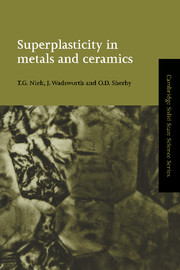Book contents
- Frontmatter
- Contents
- Preface
- Chapter 1 Introduction
- Chapter 2 Key historical contributions
- Chapter 3 Types of superplasticity
- Chapter 4 Mechanisms of high-temperature deformation and phenomenological relations for fine-structure superplasticity
- Chapter 5 Fine-structure superplastic metals
- Chapter 6 Fine-structure superplastic ceramics
- Chapter 7 Fine-structure superplastic intermetallics
- Chapter 8 Fine-structure superplastic composites and laminates
- Chapter 9 High-strain-rate superplasticity
- Chapter 10 Ductility and fracture in superplastic materials
- Chapter 11 Internal-stress superplasticity (ISS)
- Chapter 12 Other possible superplasticity mechanisms
- Chapter 13 Enhanced powder consolidation through superplastic flow
- Chapter 14 Superplastic forming and diffusion bonding
- Chapter 15 Commercial examples of superplastic products
- Index
Chapter 13 - Enhanced powder consolidation through superplastic flow
Published online by Cambridge University Press: 15 October 2009
- Frontmatter
- Contents
- Preface
- Chapter 1 Introduction
- Chapter 2 Key historical contributions
- Chapter 3 Types of superplasticity
- Chapter 4 Mechanisms of high-temperature deformation and phenomenological relations for fine-structure superplasticity
- Chapter 5 Fine-structure superplastic metals
- Chapter 6 Fine-structure superplastic ceramics
- Chapter 7 Fine-structure superplastic intermetallics
- Chapter 8 Fine-structure superplastic composites and laminates
- Chapter 9 High-strain-rate superplasticity
- Chapter 10 Ductility and fracture in superplastic materials
- Chapter 11 Internal-stress superplasticity (ISS)
- Chapter 12 Other possible superplasticity mechanisms
- Chapter 13 Enhanced powder consolidation through superplastic flow
- Chapter 14 Superplastic forming and diffusion bonding
- Chapter 15 Commercial examples of superplastic products
- Index
Summary
A practical method for superplastic forming of bulk material is through the use of powder metallurgy methods. The approach here is to achieve net-shaped products, with high density, by compaction of both metal and ceramic powders, using fine-structure or internal-stress superplasticity (FSS and ISS) methods. Studies have been performed by Ruano et al. on the use of ISS in enhancing the densification of white cast iron powders. Caligiuri and Isonishi and Tokizane, on the other hand, used FSS to enhance the densification of ultrahigh carbon steel (UHCS) powders. In addition, Allen used FSS to consolidate Ni-based IN-100 powders (GatorizingTM* process). For ceramics, Kellett et al. used FSS to extrude fine zirconia powders and Wakai et al. to perform the bulge forming of YTZP pipes directly from powders. Panda et al. Akmoulin et al., Uchic et al., and Kwon et al. have sinter forged nanometer zirconia, titania, and alumina powders.
ISS compaction of white cast iron powders
The advent of new technologies centered on fine powders often requires development of methods of enhancing densification wherein the fine structures present in such powders are retained. Low temperatures must be used to achieve this goal, but this usually requires the application of high pressures if a high density is to be achieved. High pressures are often a limiting factor in the manufacture of powder products.
- Type
- Chapter
- Information
- Superplasticity in Metals and Ceramics , pp. 231 - 238Publisher: Cambridge University PressPrint publication year: 1997



